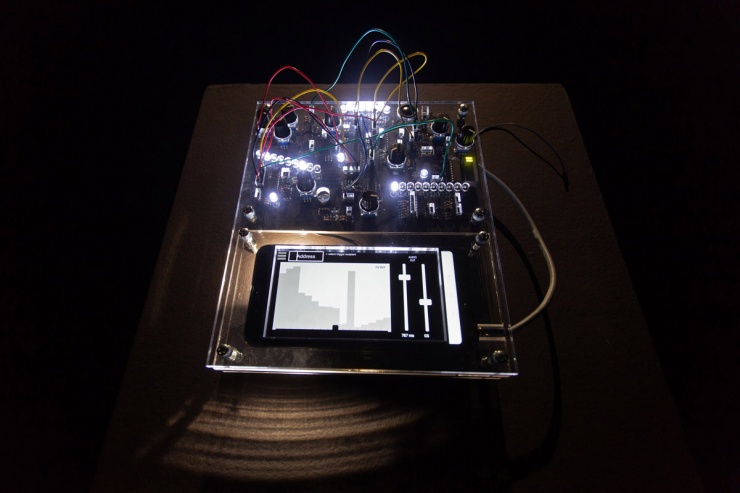Staš Vrenko: Loops in Transmission
Interactive sound installation
With the project Loops in Transmission Staš Vrenko continues his exploration of hardware and software processes of recording, storing, processing and transmitting of sound that was already the basis of his past works Connective and Adoption Techniques.
The project deals with technical media that are capable of constructing specific modalities of measuring and recording time while also creating unique technology-based temporalities. Interactive sound installation Loops in Transmission is based as an interactive system of three identical sound devices or tools intended for processing of sound and logical signals. The foundation of each tool are smartphone applications developed for this specific purpose, extended with a selection of analogue-digital modular electronic circuits. Through a system of (electromagnetic and data) feedbacks in individual devices and through feedback on the level of communication between devices via LAN connection, Loops in transmission resonate and sonify the microtemporal processes of analogue and digital tech media that are otherwise inaccessible to human perception.
Vsebina
Concept
Loops in Transmission continues Staš Vrenko’s exploration of hardware and software processes of recording, storing, processing and sound transmission. These were already the basis of his past works, namely Connective and Adoption Techniques, whereas in the latest project his interest in sound occurrences expands also to sonicity. As defined by German media theorist Wolfgang Ernest, sonicity denotes the oscillation events and the frequency domain as an epistemological object and is referring to unheard events in the field of the analogue and the digital, the vibrational and rhythmic. It represents a juncture of time and technology.
Technical media that are, besides measuring and recording time, also capable of time axis manipulation, and creation of unique technology-based temporalities are defined by Ernst as time-critical media. The temporalities of these technologies can only be understood in their processual time operations through the exploration of technical signals of algorithmic processes, not through the analysis of cultural signs. Their temporalities, therefore, disrupt the human perception of time and separate the time of human culture from the time of technical media (the tone from the frequency).
Time-critical media represent an implementation of physical and mathematical laws and are therefore not merely cultural products. Mechanical storage media (phonograph, cinematography, magnetic tape …) and electronic transmission media (radio, television….) are based on analogue processes that introduce particular discontinuities by enabling storage and re-play of sounds. In the 20th century, these technical media caused crucial shifts in the field of music that was (in the Western tradition) based on the symbolisation of sound (notation) until then.
The temporality of digital devices, which transform sound signals into numeric (binary) form - once again a particular symbolised one -, is linked to the material characteristics of analogue components (e.g. RC oscillator that generates the operative frequency of digital devices). Mathematised sonicity is also present in certain electronic sound synthesizers, in which digital signals function as trigger and gate signals or as square-wave sounds. The transition from the analogue to the digital paradigm also represents a shift in procedures of temporal processing from the use of signal delay lines to micro-temporal calculated time windows. These make the digitally calculated real-time fundamentally dynamic: »The computer was never as time-critical [...] [T]he necessary connections corresponding to the commands coded in working memory are only established when needed, which results in greater flexibility in the time-critical field.« 1

Photo:Nada Žgank
The interactive sound installation Loops in Transmission explores the unperceivable time processes of technical media – specifically their implicit sonicity – through a system of three identical sound devices. These three are dedicated to sound and logical signals processing both on the software and on the hardware level; the basis of the individual devices’ processes are custom-built applications running on smartphones, enhanced with a selection of electronic circuits based on analogue-digital chips. The processing of electromagnetic signals (in waveforms) intervenes with the temporality of digital media (smartphone or mobile applications). The circuit enables direct intervention in the digital output signal, which is being processed according to analogue and digital principles. Another intriguing “shift” in the circuit however is the transition of the electric signal into the form of sound on a minimal physical distance between the speaker and the microphone which are both integrated within the circuit.
The key level of the instruments is the system of (electromagnetic and data) feedback loops in individual devices and loops on the level of communication between the devices through a LAN connection. The function of feedback loops in Loops in Transmission can be thought through the prism of Alvin Lucier’s work I am sitting in a room (1969), in which the play and record feedback of speech amplifies the resonating frequencies of the space and blurs words into rhythmical sonority. This procedure transforms sound into a »chrono-poetic event where the true chrono-poet is the recorder itself«.2
Similarly, through self-resonating of the technical media itself, and with series of real-time signal amplification, the dynamic feedbacks in Loops in Transmission inevitably also amplify the latencies which, in the interaction with technology, brings to the forefront the vast quantity of micro-temporal configurations needed for successful media operations. The system of feedback loops enables an indirect sonification of the micro-temporal processes of analogue and digital technology media. Therefore, Loops in Transmission can be at once understood as a sound and a measuring tool, an instrument based on a specific (media archaeological) method that is not »just a human mode of understanding technology, [but] is also a form of technical perception in which the technological device itself turns into a listening organ.« 3 This said, the ‘technological message of the media’ also becomes its musical substance.
Maja Burja
1Wolfgang Ernst, Chronopoetics: The Temporal Being and Operativity of Technological Media, Rowman & Littlefield International, London 2016, 88.
2Wolfgang Ernst, Sonic Time Machines: Explicit Sound, Sirenic Voices, Implicit Sonicity, Amsterdam University Press, Amstredam 2016, 39.
3Ibid, 31.
Events
Robert Bobnič: In Search of Machine Time (lecture)
Date: 4 January 2019 at 6PM
Through the project Loops in Transmission the lecture will follow the path of media-archaeologic and its techno-epistemological understanding of a operability of time within technologically mediated and automated processes of sonicity. On this basis, we will then try to specifically contemplate on the recursive and affective (time) economy of digital cultures and aesthetics. In addition, the concept of a loop will be conceptualized as a potential uncontrolled affection.
Robert Bobnič (1985) is a Ph.d. candidate of Media Studies at the Faculty of Social Sciences of the University of Ljubljana, editor, and writer. Since 2017 he has been a member of the editorial board of the magazine ŠUM, and in the past worked as editor of the Department for Culture and Humanities Radia Študent (2013-2016) and as editor-in-chief of Tribuna (2011-2012). He is a member of the collective ŠOP Records.
Voranc Kumar & Staš Vrenko (talk)
Date: 10 January 2019 at 6PM
At the closure day of the interactive sound installation Loops in Transmission, Voranc Kumar (ŠUM) will lead a discussion with author Staš Vrenko on a series of questions that characterize the artist’s practice.
Voranc Kumar (1990) holds the master's degree in sculpture and is a Ph.d. student of philosophy at the Faculty of Arts (UL FF). He works as scenographer and video artist for theatre productions, visual artist and writer and editor. Since 2011 he worked on more than twenty theatre productions in Slovenia, Croatia, Serbia, and Italy. Since 2013 he took part in various group exhibitions in Slovenia and abroad, and presented his work at two solo exhibitions in Škuc Gallery and P74 Gallery. Since 2018 he works at ŠUM – a journal for contemporary art and theory as writer and editor.
Past events
- 26th Biennial of Design: Common Knowledge, Ljubljana | November 14 - February 9 2020
- Agora Créative 2019 (EASTN-DC), Grenoble (FR) | October 15th – 19th, 2019
- International Festival of Computer Art IFCA, Maribor | October 11th – 18th, 2019
- 27 December 2018 – January 2019 @ osmo/za, Ljubljana
About the author
Staš Vrenko (1991) is a media artist, musician, and designer of electronic instruments. He holds a master’s degree from the Department of Sculpture at ALUO in Ljubljana. His artistic practice combines different fields of art, with an emphasis on research into sound, electronic media & technologies, kineticism and performativity. In recent years, he presented his work in several solo projects: Record (Kino Šiška, 2019), Loops in Transmission (osmo/za, 2018), Adoption Techniques (P74, 2017) and Connective (MoTA, 2016). He has also exhibited in several group exhibitions, for example in Common Knowledge/26th Biennial of Design (MAO, 2019), international festival Agora Creative(Grenoble, 2019), Automated Ecologies/MFRU_25 (2019),the Kiblix International Festival (2017), the International Guerrilla Light Festival (2015 and 2016), Vžigalica Gallery (2012), Škuc Gallery (2013), as part of the Liminale Project at U3 | 7. Triennial of Contemporary Arts in Slovenia (SCCA Ljubljana, 2013), and elsewhere.
Author: Staš Vrenko
Curator: Lenka Đorojević
Text and co-curating: Maja Burja
Production: Ljudmila Art and Science Laboratory (Tina Dolinšek) and Projekt Atol Institute (Uroš Veber).
Credits: RogLab, Luka Frelih, Daniel Iglesia and Uroš Veber
The project is being realized in cooperation with the ŠUM magazin and is supported by MOL – Department for Culture and Slovene Ministry of Culture. It is part of EASTN-DC Network, which is co-funded by the Creative Europe programme of the European Union.


